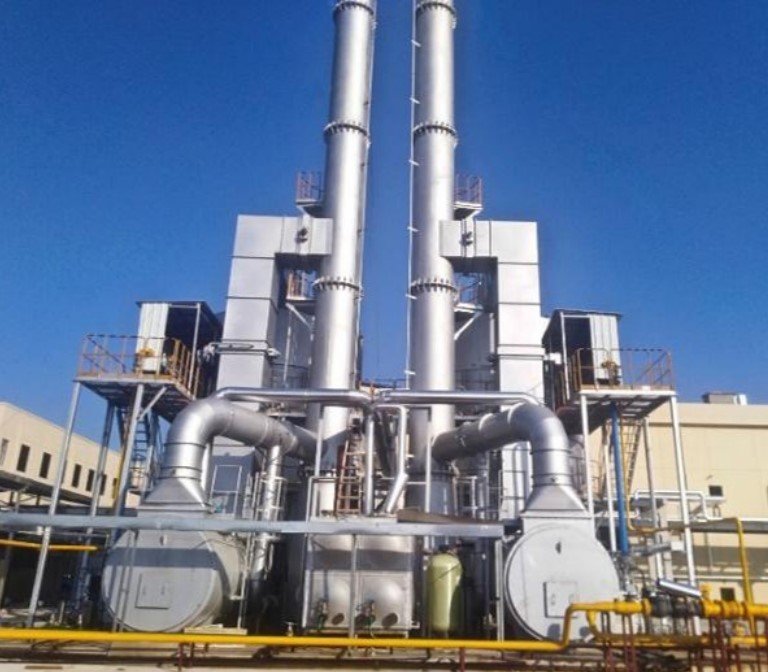Volatile Organic Compounds (VOCs) are a significant environmental concern, particularly in industries such as petrochemicals, painting, packaging, and semiconductor manufacturing. These airborne pollutants contribute to smog formation, pose health risks, and are subject to stringent environmental regulations. To mitigate VOC emissions effectively, industries require efficient and sustainable solutions. One of the most effective technologies for VOC control is the Regenerative Thermal Oxidizer (RTO). These systems provide an environmentally friendly way to eliminate hazardous pollutants while ensuring energy efficiency and compliance with regulations.
How Regenerative Thermal Oxidizers (RTOs) Work in Industrial VOC Treatment
A Regenerative Thermal Oxidizer (RTO) is an advanced air pollution control system designed to destroy VOCs through high-temperature thermal oxidation. The process involves several key steps:
- VOC-laden air enters the RTO system: Contaminated air from industrial processes is directed into the RTO unit.
- Preheating through ceramic heat exchangers: The incoming air is preheated by passing through ceramic heat exchanger beds that have stored heat from previous oxidation cycles.
- Oxidation at high temperatures: The preheated air enters the combustion chamber, where it is exposed to temperatures ranging from 1400°F to 1600°F (760°C to 870°C). This process effectively breaks down VOCs into harmless carbon dioxide (CO₂) and water vapor (H₂O).
- Heat recovery for energy efficiency: The hot, purified air then passes through the ceramic heat exchanger beds, transferring its heat before being safely released into the atmosphere. This regenerative process significantly reduces fuel consumption and operational costs.
Key Benefits of Using RTO Systems
Implementing an RTO system offers multiple advantages for industrial manufacturers:
- High Thermal Efficiency: RTOs achieve thermal efficiencies of up to 97%, minimizing energy consumption and operational costs.
- Significant Emission Reduction: These systems effectively destroy over 99% of VOCs and hazardous air pollutants (HAPs), ensuring compliance with stringent environmental regulations.
- Lower Operating Costs: By utilizing regenerative heat recovery, RTOs minimize fuel usage, making them a cost-effective solution in the long run.
- Adaptability Across Industries: RTOs are widely used across various sectors, including petrochemical processing, automotive manufacturing, pharmaceuticals, and coating applications.
- Minimal Maintenance Requirements: With durable ceramic heat exchangers and automated control systems, RTOs require less frequent maintenance than other air pollution control technologies.
The Role of Advanced Materials in RTO Performance
The efficiency and durability of an RTO system heavily depend on the materials used in its construction. Two key materials play a crucial role:
- Ceramic Heat Exchangers: These components enable effective heat recovery, ensuring high thermal efficiency and energy savings.
- Zeolite Molecular Sieves: When combined with an RTO system, zeolite molecular sieves act as VOC concentrators, allowing for enhanced pollutant removal and further energy conservation.
Innovations in RTO Technology
The development of RTO systems continues to evolve with technological advancements. Key innovations include:
- Smart Control Systems: The integration of IoT and AI-based monitoring allows real-time tracking and optimization of RTO performance, reducing downtime and maximizing efficiency.
- Low-NOx Burners: Advanced burner designs help minimize nitrogen oxide (NOₓ) emissions, making RTOs even more environmentally friendly.
- Modular RTO Designs: Flexible and scalable RTO configurations provide industries with cost-effective solutions that can be tailored to their specific needs.
- Hybrid RTOs: Combining thermal oxidation with zeolite concentrators enhances efficiency and lowers energy consumption in VOC treatment.
Factors to Consider When Choosing an RTO Supplier
Selecting the right regenerative thermal oxidizer manufacturer is essential for ensuring optimal performance and long-term reliability. Here are key factors to consider:
- Experience and Expertise: Choose an RTO supplier with extensive industry experience and a proven track record of successful installations.
- Customization Capabilities: A reputable manufacturer should offer customized solutions tailored to your industry’s specific needs.
- Compliance with Industry Standards: Ensure the supplier meets environmental and safety regulations such as EPA, OSHA, and ISO certifications.
- After-Sales Support: Look for suppliers that provide comprehensive after-sales support, including maintenance, troubleshooting, and spare parts availability.
- Technology and Innovation: Opt for an RTO supplier that continuously innovates and integrates advanced features such as automated controls and energy-saving enhancements.
The Future of Industrial Air Pollution Control with RTOs
As industries continue to prioritize sustainability and regulatory compliance, Regenerative Thermal Oxidizers (RTOs) will play a vital role in VOC treatment. Advances in material science, automation, and energy-efficient designs will further enhance RTO performance, making them an indispensable solution for industrial air pollution control. Companies investing in high-quality RTO systems from experienced manufacturers will benefit from long-term cost savings, regulatory compliance, and a cleaner environment. For industries looking to efficiently manage VOC emissions while ensuring regulatory compliance and cost savings, investing in a high-quality RTO system from a trusted supplier is a smart choice. At Ever-Power Pte. Ltd., we specialize in advanced regenerative thermal oxidizers that help businesses achieve sustainability and operational efficiency. If you have any questions or need expert guidance, feel free to reach out to us. Call us at +65 80844634, send a fax to +65 80844634, or email us at [email protected]—our team is ready to assist you.











